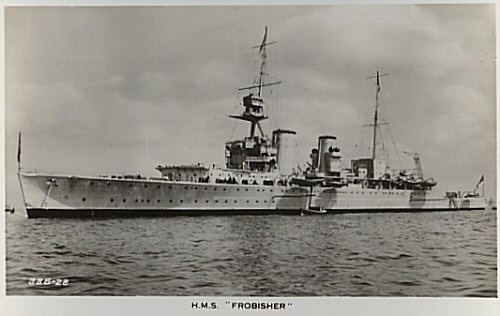
Sold for Scrap 11 May 1949
After commissioning in September 1924 HMS Frobisher served with the Mediterranean Fleet as flagship to the 1st Cruiser Squadron, with a temporary detachment to the China Station in 1926. In 1927 Frobisher was fitted with a catapult on the quarter-deck, together with a crane. This displaced one 4 inch gun, which was re-sited between the funnels with a fourth gun. In 1929 during a refit the cruiser was fitted with oil fired boilers, and then joined the Atlantic Fleet. In November 1930 Frobisher was reduced to reserve until conversion to Cadets Training Ship. From 1932 until 1939 Frobisher was used as a training ship. In early 1939 the cruiser was laid up, until the declaration of war. In January 1940 Frobisher started an extensive refit. The ship was rearmed with five 7.5 inch, and five 4 inch guns, and quadruple 2 pdr pom-pom and 19 20 mm Oerlikons.
In March 1942 HMS Frobisher joined the 4th Cruiser Squadron of the Eastern Fleet which operated in the Indian Ocean. On May 15th, convoy WS-18 arrived in South Africa from the U.K. The convoy ran into a minefield off Cape Agulhas, laid by the German mercantile minelayer Doggerbank on April 17th, which resulted in the sinking of the British merchant Soudan (6677 BRT) and damage to the destroyer depot ship HMS Hecla which was with the convoy. The convoy was enroute to Burma via India and consisted of 17 ships of which Frobisher was the escort. On July 18th, convoy WS-20 arrived in South Africa from the U.K. escorted by HMS Frobisher, HMS Shropshire and the armed merchant cruiser HMS Worcestershire with the 51st Division embarked for operations in the western desert. The convoy consisted of 18 ships. On December 4th, convoy WS-24 arrived in South Africa from the U.K. with reinforcements, the convoy consisted of 16 ships Frobisher supplied the escort.
In the early part of 1943 Frobisher was involved in the escorting of supply convoys passing around the Cape of Good Hope to the Suez Canal. May 17-31st, was spent in the Selborne dry dock at Simonstown, South Africa.
In March 1944 Frobisher returned to the U.K. On June 6th the cruiser was a member of Gunfire Bombardment Support Force D under Rear Admiral Patterson. This force was allocated to “Sword" in the D-Day landings. Later during the month she was deployed as a depot ship for the motor torpedo boats participating in the D-Day Armada. August saw Frobisher along with the repair ship Albatross were damaged by a long range German torpedo fired from E-boats in Seine Bay. The cruiser was then partly disarmed and spent her remaining years once more as a Cadet Training Ship. She was sold for scrap on 26 March 1949 and on 11 May 1949 Frobisher arrived at Newport to be broken up for scrap by Cashmore.
Her badge can be seen painted on the side of the Selborne dry dock wall, with the inscription “Semper Triumphans”.